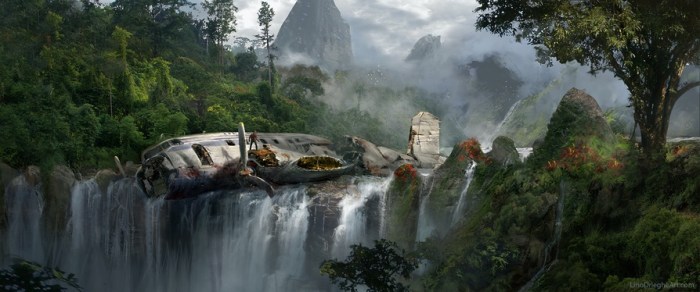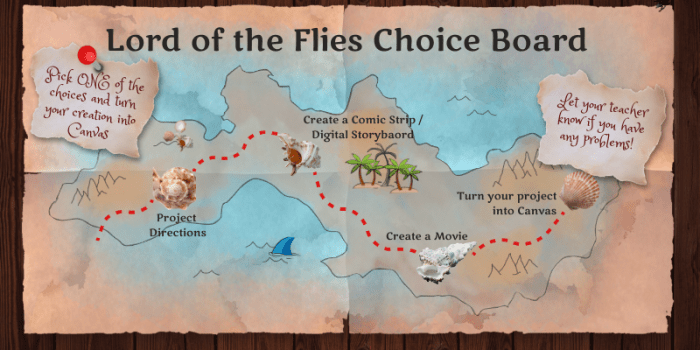Lord of the Flies Timeline: A Chronological Journey Through the Descent into Savagery.
William Golding’s Lord of the Flies is a timeless classic that explores the dark side of human nature. This timeline provides a chronological account of the key events in the novel, offering a deeper understanding of the characters’ development, the novel’s themes, and its lasting impact.
Timeline of Key Events
Lord of the Fliesis a novel by William Golding that tells the story of a group of British boys who are stranded on a deserted island after their plane crashes. The boys initially attempt to create a society based on democracy and reason, but they soon descend into savagery and violence.
The following is a chronological table of significant events in the novel:
- Day 1:The plane crashes on the island, and the boys are stranded.
- Day 2:The boys hold an election for a leader and choose Ralph.
- Day 3:The boys build a signal fire and begin to explore the island.
- Day 4:The boys encounter a beast in the forest.
- Day 5:The boys’ signal fire is extinguished, and they begin to hunt for food.
- Day 6:The boys’ society begins to break down, and they become increasingly divided.
- Day 7:The boys are attacked by the savages.
- Day 8:The boys are rescued by a passing ship.
Character Development Over Time
Throughout Lord of the Flies, the characters undergo significant transformations as they confront the challenges of survival on a deserted island. Their interactions with each other, the environment, and the moral dilemmas they face all contribute to their evolving personalities and values.
Ralph
Ralph initially emerges as a natural leader, guided by his sense of fairness and desire for order. However, as the group’s situation deteriorates, he struggles to maintain his authority against the rising tide of savagery. His idealistic vision for a civilized society clashes with the darker impulses of his companions, forcing him to confront his own limitations.
Jack
Jack, initially a rival for Ralph’s leadership, represents the primal instincts that lurk within the group. As he succumbs to the lure of power and violence, he becomes increasingly brutal and dictatorial. His transformation symbolizes the dangers of unchecked aggression and the loss of humanity in the face of adversity.
Piggy
Piggy, the intellectual and voice of reason, is marginalized and persecuted by the other boys. His rational thinking and insistence on rules are met with hostility, highlighting the group’s rejection of logic and order. His death marks a turning point in the novel, signaling the triumph of savagery over civilization.
Simon
Simon, the visionary and spiritual guide, possesses a deep understanding of the group’s true nature. His attempts to reconcile the boys with their darker impulses are met with rejection, and he is ultimately killed as a scapegoat for their fears and guilt.
His death represents the silencing of wisdom and the failure of the group to confront its own darkness.
Themes and Symbolism
Lord of the Fliesexplores profound themes and employs powerful symbols to convey its message about the duality of human nature.
The Duality of Human Nature
The novel delves into the inherent conflict between civilization and savagery, highlighting the delicate balance between the two within each individual. The boys initially attempt to maintain order and structure, but as their society deteriorates, their primal instincts take over, leading to chaos and violence.
The Loss of Innocence
The boys’ journey on the island symbolizes the loss of childhood innocence. As they face the challenges of survival and the darkness within themselves, they are forced to confront the harsh realities of life. The conch shell, a symbol of order and authority, gradually loses its power as the boys succumb to their darker impulses.
The Power of Fear
Fear is a driving force throughout the novel. The boys’ fear of the unknown, represented by the “beast,” amplifies their paranoia and leads to irrational behavior. The fear of being left behind or killed fuels their descent into savagery.
The Importance of Leadership
Leadership plays a crucial role in shaping the boys’ society. Ralph, the initially elected leader, represents reason and order, while Jack, the leader of the hunters, embodies instinct and violence. The struggle between these two characters highlights the importance of balancing different leadership styles.
The Symbolism of the Island, Lord of the flies timeline
The island itself is a powerful symbol. It represents a microcosm of the world, where the boys’ actions have far-reaching consequences. The island’s lush vegetation and abundance of resources initially provide hope and sustenance, but as the boys’ society deteriorates, the island becomes a place of fear and despair.
Literary Devices and Techniques

William Golding employs a wide range of literary devices and techniques in “Lord of the Flies” to create suspense, foreshadowing, and other effects that contribute significantly to the novel’s overall impact.
These techniques include:
Symbolism
Golding uses symbols extensively throughout the novel. For example, the island itself symbolizes both the beauty and the danger of nature, while the conch shell represents order and civilization.
Foreshadowing
Golding uses foreshadowing to create a sense of suspense and to hint at future events. For example, the boys’ first encounter with the “beast” foreshadows the savagery that will eventually overtake them.
Irony
Golding uses irony to create a sense of contrast between the boys’ initial expectations and the reality of their situation. For example, the boys initially believe that they will be able to create a utopia on the island, but they quickly descend into chaos.
Suspense
Golding uses a variety of techniques to create suspense, such as cliffhangers, foreshadowing, and the use of vivid imagery. For example, the novel’s opening scene, in which the boys crash-land on the island, is full of suspense.
The ati pharm practice b 2019 had to be revised to make it more comprehensive. The Lord of the Flies timeline has been revised to reflect these changes. The revised timeline provides a more accurate and detailed account of the events that occur in the novel.
Imagery
Golding uses vivid imagery to create a strong sense of atmosphere and to convey the boys’ emotional states. For example, the description of the island as a “green and gold world” conveys a sense of beauty and peace, while the description of the boys as “savages” conveys a sense of danger and chaos.
Characterization
Golding’s use of characterization is complex and nuanced. He creates a wide range of characters, each with their own unique strengths and weaknesses. For example, Ralph is a natural leader, while Jack is a ruthless and violent savage.
These literary devices and techniques combine to create a novel that is both suspenseful and thought-provoking. “Lord of the Flies” is a classic of English literature that continues to be read and studied today.
Comparison to Other Works: Lord Of The Flies Timeline

Lord of the Fliesexplores universal themes that resonate across literary works. Here’s a comparative analysis with two notable novels:
Comparison to “The Catcher in the Rye”
The Catcher in the Rye, by J.D. Salinger, also delves into the disillusionment of youth. Holden Caulfield, the protagonist, struggles with the superficiality of society and seeks authenticity. Like Ralph, Holden grapples with the conflict between innocence and experience, questioning the corruption that exists in the adult world.
Comparison to “Heart of Darkness”
Joseph Conrad’s Heart of Darknesspresents a similar exploration of the darker aspects of human nature. Marlow, the narrator, journeys into the Congo, where he encounters the horrors of colonialism and the savagery that lurks within civilized societies. Like Lord of the Flies, Heart of Darknessexamines the fragility of civilization and the potential for regression to barbarism.
Essential Questionnaire
What is the significance of the conch shell in Lord of the Flies?
The conch shell symbolizes order, civilization, and the rule of law. Its destruction marks the descent into chaos and savagery.
How does Piggy’s character evolve throughout the novel?
Piggy initially represents reason and intelligence, but he is gradually marginalized and ultimately killed, reflecting the triumph of savagery over civilization.
What is the central theme of Lord of the Flies?
The central theme is the conflict between civilization and savagery, and the inherent darkness within human nature.